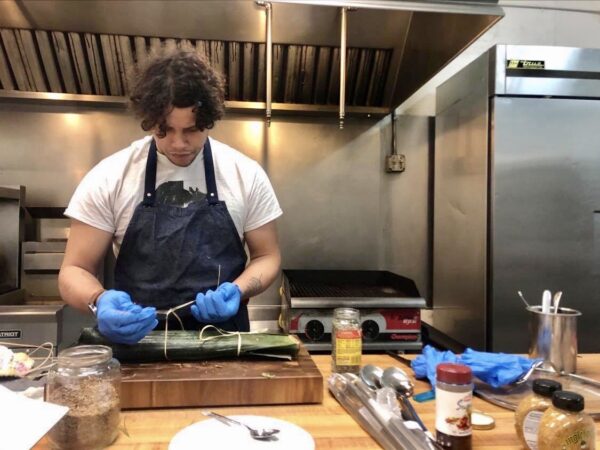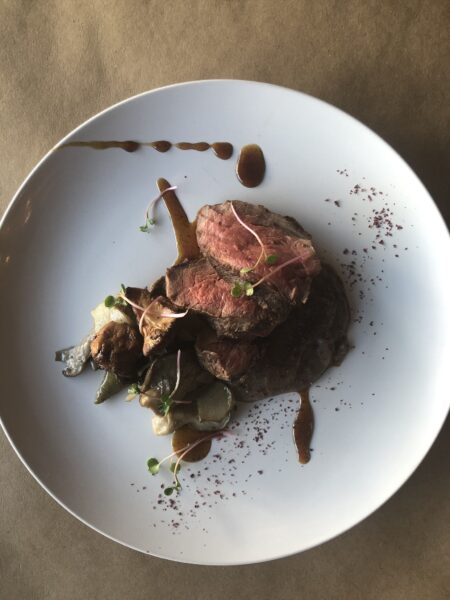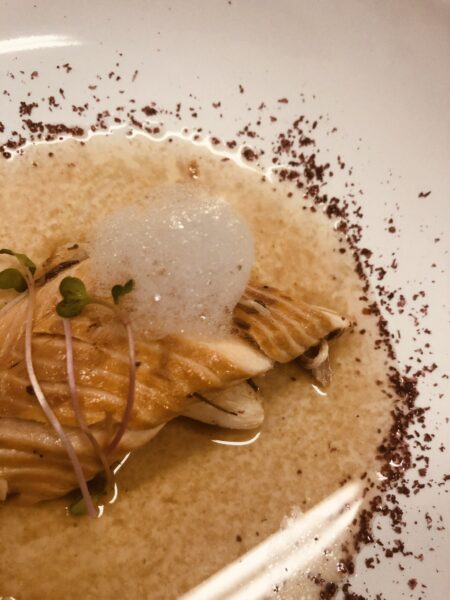
- Details
- By Rich Tupica
At just 24-years old, Anishinaabe personal chef Camren Stott has already made a name for himself in Michigan for his indigenous-inspired food, which is served up via his own company, Jiibaakwaan Foods. Stott, a tribal member of The Little Traverse Bay Band of Odawa Indians, uses his company to do traditional catering, but also in-home meal planning and food pop-ups.
The emerging chef is also sharing his knowledge in classrooms, including lectures at Blandford Nature Center and Cook Arts Center. In the fall, he’ll offer up food lectures at Grand Rapids Community College’s Secchia Institute for Culinary Education. Looking back, his love for Indigenous dishes really took off after he took on a culinary internship through the Native American Food Sovereignty Alliance (NAFSA). From there, he started attending multiple Intertribal Food Summit events and was able to cook alongside established Native American chefs from across the country. He brought that knowledge back to his homebase of Grand Rapids, Mich., where he now operates Jiibaakwaan Foods. “For me personally, I feel like it is my responsibility to re-establish that connection between us and the land, animals, and sea that sustains us, and I thrive to indoctrinate our food traditions through food sovereignty,” he said. “The meals that I prepare are not just a bundle of random ingredients thrown together. They are an invitation to participate in traditional food ways.” Despite COVID-19 shutting down much of the catering industry, Stott has pivoted his business and continues to keep busy as possible — while also helping elders and others in need. This week, he chatted with Native News Online, here’s what he had to say about his mission to keep tribal traditions alive in his tasty dishes.
 Bison tenderloin, nopales and sunchoke medley, blue corn mush and cedar gastrique. Courtesy photo.
Bison tenderloin, nopales and sunchoke medley, blue corn mush and cedar gastrique. Courtesy photo.
Jiibaakwaan Foods is deeply rooted in tribal culture, was that a large part of your upbringing? Camren Stott: I didn’t really grow up immersed in the culture. I grew up on the west side of Grand Rapids and a lot of people there are disconnected with the original teachings and traditions. This isn’t something that I would come back to until later on in my life. I started learning more about food systems and how they correlate with my ’nish ancestry and everything started making sense. I knew what I was called to do with that knowledge.
What was it that initially interested you in becoming a chef? I first started getting interested in cooking by wanting to understand the science of it, that intrigued me. But the real reason stemmed from my love of nourishing others and finding the comfort in a well-cooked meal.
In what ways do tribal traditions inspire your menu?
Here’s a quick story. When I was a kid I used to smell sage and sweetgrass at the Powwows held in my community twice a year. I never knew what it was, but I always felt like I smelled it before. It felt so familiar to me and made me feel safe. From then on, I started smelling it from time to time everywhere I went. I was thinking, “What is that smell, and why is it so familiar?”
When I learned more about sage and sweetgrass, I felt the urge to use that in my cooking. I smell ingredients and let my senses take a culinary turn. I mostly try to incorporate anything pre-colonial. Big staples for me are wild rice, game meat, berries, corn, squash and beans. I also try to integrate foraged ingredients because these foraged plants were used as medicine by our ancestors. I’d like to think by consuming these healthy, fulfilling ingredients we become closer with our ancestors.
Do you have any values or ethics you insist on being in each dish you serve?
I always incorporate sustainable uses of my ingredients into my dishes. Whether that consists of reusing the water I cook my white corn in or blending my used tea leaves to make a marinade. That is what gives me the driving force in my creativity and also connects me further with the land. I like to use fresh ingredients from the farmers markets, co-ops, or growing it myself. Processed foods don’t have the same spark after having all its nutrients overly processed out of them. Another thing I always do is substitute traditional ingredients into modern cuisine, it makes it a little easier to introduce to your palate.
 Clay baked trout, served with elderflower foam in a kombu broth. Courtesy photo.
Clay baked trout, served with elderflower foam in a kombu broth. Courtesy photo.
How did your passion become an actual business?
Jiibaakwaan Foods started out kinda rough. My menu consisted of stuff I wouldn’t normally serve. I wanted to assimilate my idea of western food into what I was serving and only giving people what I thought they wanted. What I’m talking about is fry bread. Everyone loves it, I mean I love it. But that’s not how I want Native American food to be represented. Anything being associated with Native American cuisine should be associated with the key words “nourishing” and “fulfilling.” I’m trying to regulate the urges of stomachache-inducing food. I finally educated myself enough to be able to reinforce that ideology into what I serve. It’s become my model.
It’s June and COVID-19 is still looming, how have you been holding up?
Right now, my focus has been set on, “How can I serve my community at a time like this?” I’m in the process of getting my food license to operate out of a commercial kitchen doing curbside pickup at a convenient price and free for elders. With the support of my community, I hope to feed all the elders in my community for free at least a couple times a day. I do that on a micro scale within my own network of people, but I’d like to expand that and give nourishing food to more of my community. I want to make food as accessible as possible to every demographic. It’s everyone’s birthright to have access to healthy food at little to no costs. So I want to focus on that before I go back to dinner parties and catering. I’ve had a lot of success getting my food out there, an overwhelmingly good response. I hope to do more business in the future. I also want to get back into the foraging medicines classes.
Is foraging a consistent part of your life?
When I’m not cooking I’m usually always foraging. I like to bring my kids out with me and teach them all about traditional medicines. Right now, I’m very dedicated to my school work and working towards getting my BA in environmental science and sustainable food systems.
Are you able to pick a favorite dish or two?
That’s a toughy! I make so many dishes and can't even remember all of them, but I think one of my favorites would have to be the willow-bark smoked rabbit dish. It comprises brûlée wildberries, amaranth tuiles and rosehip gel. It just hit every component spot on. The smokiness of the rabbit and brûlée wildberries, the savoriness of amaranth tuiles and the sweetness of the rose hips made it an all around good dish.
Since your start a few years back, how have your cooking methods changed?
Over the years, my cooking has been evolving in a more positive trend. I owe that to the deconstruction of everything I knew about cooking and reapplying everything through a traditional lens. It took time to really get to know the ingredients I was serving and — every chef needs to experience cooking this way. For more information, visit jiibaakwaanfoods.com.
More Stories Like This
Native News Weekly (August 25, 2024): D.C. BriefsUS Presidents in Their Own Words Concerning American Indians
Next on Native Bidaské: Julian Brave NoiseCat on the Lumbee Nation’s 140-Year Fight for Federal Recognition
Hackers Compromise Native News Online Facebook Page
‘His stories can no longer be told.’ | Woman Pleads Guilty to 2016 Murder of Indigenous Master Woodcarver
Help us defend tribal sovereignty.
At Native News Online, our mission is rooted in telling the stories that strengthen sovereignty and uplift Indigenous voices — not just at year’s end, but every single day.
Because of your generosity last year, we were able to keep our reporters on the ground in tribal communities, at national gatherings and in the halls of Congress — covering the issues that matter most to Indian Country: sovereignty, culture, education, health and economic opportunity.
That support sustained us through a tough year in 2025. Now, as we look to the year ahead, we need your help right now to ensure warrior journalism remains strong — reporting that defends tribal sovereignty, amplifies Native truth, and holds power accountable.
 The stakes couldn't be higher. Your support keeps Native voices heard, Native stories told and Native sovereignty defended.
The stakes couldn't be higher. Your support keeps Native voices heard, Native stories told and Native sovereignty defended.
Stand with Warrior Journalism today.
Levi Rickert (Potawatomi), Editor & Publisher
